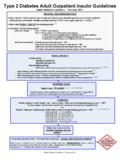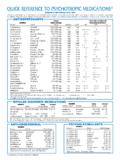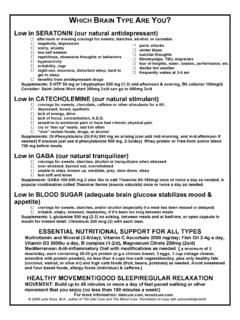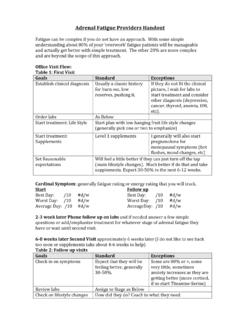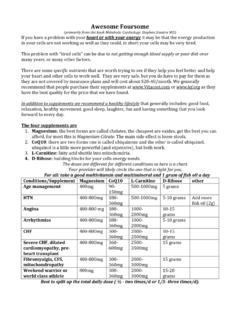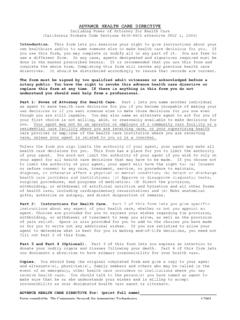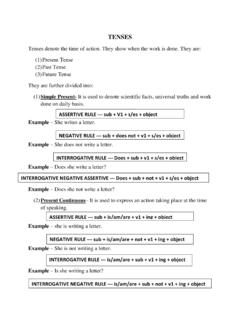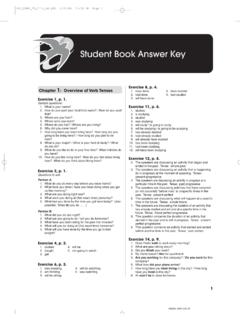Transcription of Stress Management Techniques-1
1 Stress Management Techniques To manage the effects of the Stress response ( fight-or-flight') on your body. In the Moment Techniques Breath 1. Deep Breathing: Deep breathing is a simple but very effective method of relaxation. It works well in conjunction with other relaxation techniques such as Progressive Muscular Relaxation, relaxation imagery and meditation to reduce Stress . To use the technique , take a number of deep breaths and relax your body further with each breath. That's all there is to it! 2. Abdominal breathing or 3 part breathing: Place hands on belly. Hands should go out with your belly on inhale, in on the exhale. Repeat until feeling relaxed. Alternative: start with abdomen and expand to chest and shoulders, then reverse on exhale.
2 3. Breath Counting It may be helpful to count on inhale and exhale: 5 seconds of inhale 5 seconds of exhale OR. 4/7/8 Inhale for 4 seconds, Hold for 7 seconds, Exhale for 8 seconds Freeze-Frame! technique from the book Transforming Stress by Doc Childre this takes some practice and works great for people that are able to visualize well (great for worriers!). Step 1 SEE and PAUSE: Recognize the stressful feeling, see it-visualize it, then pause it, like pushing the Pause button on your DVD or taking a time-out! Step 2 HEART BREATH: Take a deep breath. Make a sincere effort to Shift your focus away from the racing mind or disturbed emotions to the area around your heart. Pretend you've breathing through your heart to help focus your energy in this area.
3 Keep your focus there for ten second or more. Step 3 RECALL and FEEL: Recall a positive, fun feeling or time you've had in your life and attempt to re-experience it. Focus on the feeling rather than the thoughts or visual image. Activate the positive emotion. OPTIONAL Step 4 Using your intuition, common sense and sincerity Ask your heart, what would be a more efficient response to the situation you are Freeze-Framing, one that will minimize future Stress ? OPTIONAL Step 5 Listen to what your heart says in answer to your question. Compiled by Ben Brown, MD. technique for Physical Tension Progressive Muscular Relaxation (PMR): Progressive Muscular Relaxation is useful for relaxing your body when your muscles are tense. The idea behind PMR is that you tense up a group of muscles so that they are as tightly contracted as possible.
4 Hold them in a state of extreme tension for a few seconds. Then, relax the muscles to their previous state. Finally, consciously relax the muscles even further so that you are as relaxed as possible. By tensing your muscles first, you will probably find that you are able to relax your muscles more than would be the case if you tried to relax your muscles directly. Experiment with PMR by forming a fist, and clenching your hand as tight as you can for a few seconds. Then relax your hand to its previous tension, and then consciously relax it again so that it is as loose as possible. You should feel deep relaxation in your hand muscles. For maximum relaxation you can use PMR in conjunction with breathing techniques and imagery.
5 technique for Racing Mind The Relaxation Response : Try the following 6-step relaxation response from the book called The Relaxation Response, by Dr. Herbert Benson the next time you feel anxiety or Stress : Sit quietly in a comfortable position. Close your eyes. Deeply relax all of your muscles, beginning at your feet and progressing up to your face. Keep your muscles relaxed. Breathe through your nose. Become aware of your breathing. As you breathe out (exhale), say the word, ONE , silently to yourself. For example: breathe IN OUT, ONE , -IN OUT, ONE , etc. Breathe easily and naturally. Continue for 10 to 20 minutes (depending on your schedule). You may open your eyes to check the time, but do not use an alarm. When you finish, sit quietly for several minutes, at first with your eyes closed, then with your eyes opened.
6 Do not stand up for a few minutes. Do not worry about if you are successful in achieving a deep state of relaxation. When distracted, simply return to repeating ONE.. Besides relying on this technique a few times each day, I recommend using it to get to sleep at night, especially after a long, hard day or before a tough next day. It's simple, It can fit it in to your day when needed, it is fast, reliable and most importantly, it works! See also Freeze Frame above Compiled by Ben Brown, MD.
